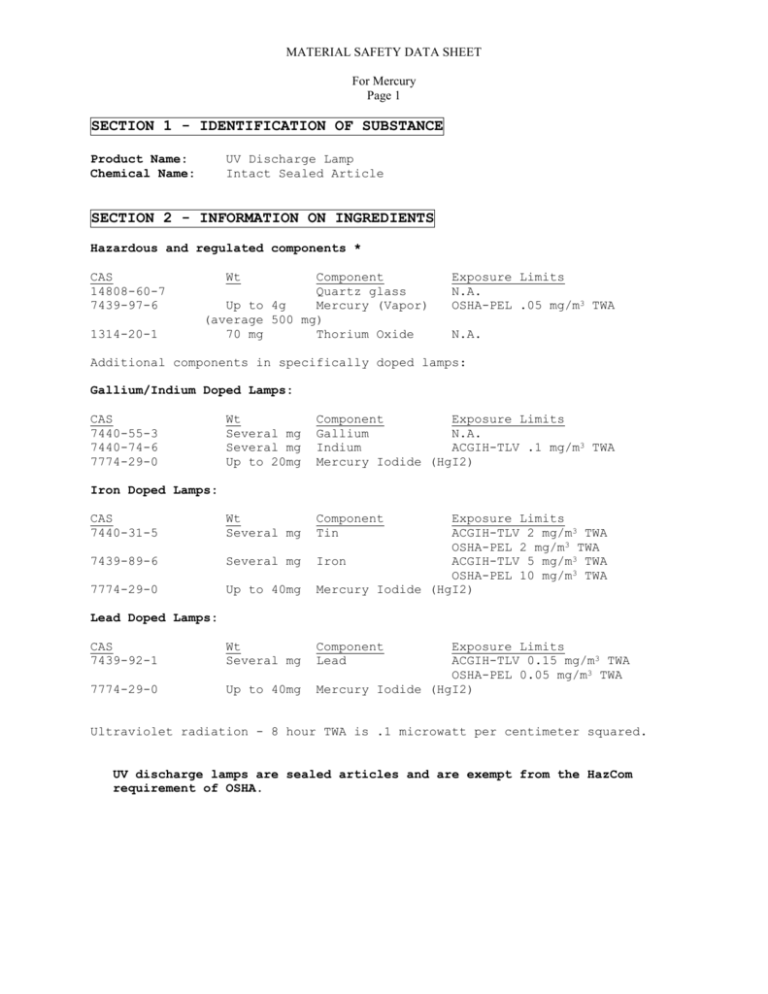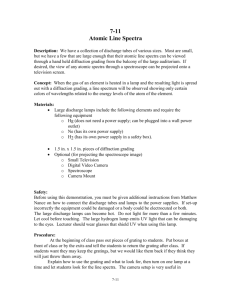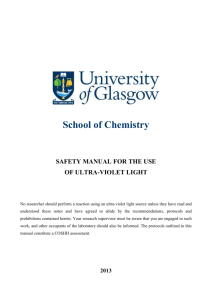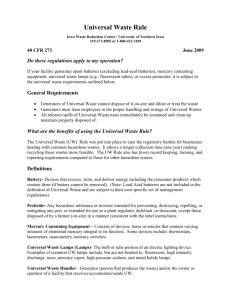MSDS for Mercury - Southern Lamps, Inc.
advertisement

MATERIAL SAFETY DATA SHEET For Mercury Page 1 SECTION 1 - IDENTIFICATION OF SUBSTANCE Product Name: Chemical Name: UV Discharge Lamp Intact Sealed Article SECTION 2 - INFORMATION ON INGREDIENTS Hazardous and regulated components * CAS 14808-60-7 7439-97-6 1314-20-1 Wt Component Quartz glass Up to 4g Mercury (Vapor) (average 500 mg) 70 mg Thorium Oxide Exposure Limits N.A. OSHA-PEL .05 mg/m3 TWA N.A. Additional components in specifically doped lamps: Gallium/Indium Doped Lamps: CAS 7440-55-3 7440-74-6 7774-29-0 Wt Several mg Several mg Up to 20mg Component Exposure Limits Gallium N.A. Indium ACGIH-TLV .1 mg/m3 TWA Mercury Iodide (HgI2) CAS 7440-31-5 Wt Several mg Component Tin 7439-89-6 Several mg 7774-29-0 Up to 40mg Exposure Limits ACGIH-TLV 2 mg/m3 TWA OSHA-PEL 2 mg/m3 TWA Iron ACGIH-TLV 5 mg/m3 TWA OSHA-PEL 10 mg/m3 TWA Mercury Iodide (HgI2) CAS 7439-92-1 Wt Several mg Component Lead 7774-29-0 Up to 40mg Iron Doped Lamps: Lead Doped Lamps: Exposure Limits ACGIH-TLV 0.15 mg/m3 TWA OSHA-PEL 0.05 mg/m3 TWA Mercury Iodide (HgI2) Ultraviolet radiation - 8 hour TWA is .1 microwatt per centimeter squared. UV discharge lamps are sealed articles and are exempt from the HazCom requirement of OSHA. MATERIAL SAFETY DATA SHEET For Mercury Page 2 SECTION 3 - HAZARDS IDENTIFICATION Effects of Overexposure: EYES: conjunctivitis from overexposure to the light source; eye irritation from inhalation of ozone; see the coating MSDS for additional hazards. SKIN: Erythema (sunburn) which may be exaggerated with the use of sensitizing pharmaceutical and herbal products; see the coating MSDS for additional hazards. INHALATION: none from UV discharge lamp, inhalation of ozone may irritate the nose or cause headache and nausea; see the coating MSDS for additional hazards. ORAL: none from UV discharge lamp; inhalation of ozone may irritate the throat; see the coating MSDS for additional hazards. SECTION 4 - FIRST AID MEASURES Skin: Eyes: Inhalation: Ingestion: conjunctivitis welders flash treatment No first aid should be needed due to ultraviolet exposure. No first aid should be needed due to ultraviolet exposure. Comments: Additional hazards may be created from exposure to the coating. Effects of overexposure to skin and eyes usually disappear in 48 hours. Some individuals may have an abnormally increased sensitivity to the effects of UV light. This may be the result of a sensitizing chemical or prescribed drug. Sensitization will result in an exaggerated sunburn response. Further occupational exposure to UV should be limited and the individual should be referred to a physician. SECTION 5 - EXPLOSION AND FIRE FIGHTING MEASURES Flash Point: NA Extinguishing Media: NA Special Fire Fighting Procedures: Unusual and Explosion Hazards: NA None known Hazardous Decomposition Products: None known SECTION 6 - ACCIDENTAL RELEASE / SPILL PROCEDURES MATERIAL SAFETY DATA SHEET For Mercury Page 3 Steps to be taken in case material is released or spilled: Broken UV discharge lamps should be placed in a sealed container and handled/disposed as hazardous waste. SECTION 7 - HANDLING AND STORAGE Handling: A small amount of mercury is contained in the quartz tube of UV discharge lamps. Due to the toxicity of mercury, UV discharge lamps should be handled so that breakage is minimized. Storage: Scrap UV discharge lamps may be stored for one year before being shipped for recycling. SECTION 8 - EXPOSURE CONTROLS/PERSONAL PROTECTION Engineering Controls: Install UV discharge lamps following manufacturers guidance. Operators should be trained to fully understand the recommended operating and safety procedures. Ozone generated by the process requires negative pressure exhaust. Personal Protective Equipment for Routine Handling: Safety glasses with side shield and with protection against ultraviolet light are recommended. Contact lenses should not be worn. Barrier creams or polyethylene skin protection are recommended. Industrial processes must be evaluated for additional safeguards. SECTION 9 - PHYSICAL AND CHEMICAL PROPERTIES Physical form: solid Color: clear Odor: none Specific Gravity @25C: Viscosity: n/a Freezing/Melting Point: n/a n/a Boiling Point: n/a Vapor Pressure @25C: n/a Solubility in Water: insoluble PH: n/a Volatile content: n/a Note: Energized UV discharge lamp surfaces are hot. SECTION 10 - STABILITY AND REACTIVITY Stability: UV discharge Lamps are stable Conditions to avoid: Photosensitizing agents when UV discharge lamps are energized. MATERIAL SAFETY DATA SHEET For Mercury Page 4 Hazardous Polymerization: Will not occur. Incompatible materials: None SECTION 11 - TOXICOLOGICAL INFORMATION Acute Toxicology Data for Product: No data available. SECTION 12 - ECOLOGICAL INFORMATION Environmental Fate and Distribution: No data available. SECTION 13 - DISPOSAL CONSIDERATIONS Waste Disposal Methods: Used UV discharge lamps should be handled/disposed in accordance with federal, state, and local regulations. UV discharge lamps may be returned for recycling with prior authorization. RCRA / Universal Waste: UV discharge lamps that are not recycled must be handled/disposed in accordance with RCRA regulations. Each state has specific regulations that apply to the management of spent UV discharge lamps. Recycling in the US must be in accordance with the Universal Waste rule. SECTION 14 - TRANSPORTATION INFORMATION DOT Shipping Name - Not Regulated IATA Shipping Name – Mercury contained in manufactured articles, 8, UN 2809, PG III. Applies to articles with greater than 100 mg of mercury. SECTION 15 - REGULATORY INFORMATION EPA: RCRA / Universal Waste – UV discharge lamps that are to be recycled should be placed in the original container or packaged to prevent breakage. The outer container should be dated and marked "Universal Waste" OSHA: Ultraviolet exposure is limited to 1 milliwatt per centimeter squared. exposure is regulated at 0.1 parts per million (ppm). SECTION 16 - OTHER INFORMATION Energized UV discharge lamps are photosensitizing. NOTICE Ozone MATERIAL SAFETY DATA SHEET For Mercury Page 5 Information contained herein has been obtained from recognized technical sources. Compliance with all federal, state, and local laws and regulations remains the responsibility of the user.





